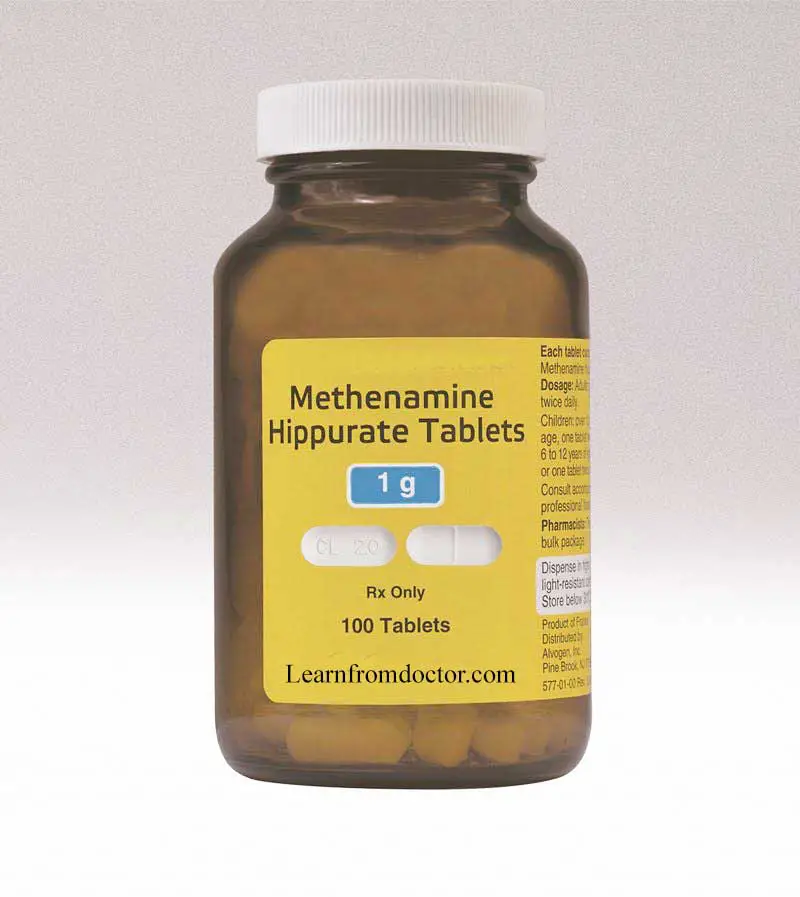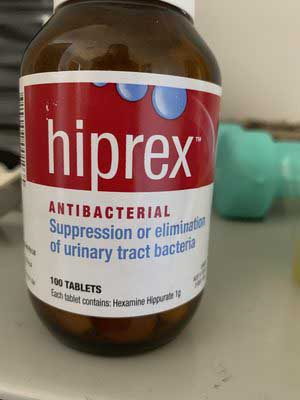Table of Contents
Methenamine Overview
The salt of mandelic acid and methenamine is methenamine mandelate. It has properties similar to both of these urinary antiseptics. The available brand name of methenamine is Hiprex and Urex.
Hippuric acid and methenamine are combined to form methenamine Hippurate(salt).
Methenamine produces formaldehyde, which is antibacterial when the pH falls below 5.5.
When ingested orally, Mandelic acid or hippuric acid is excreted unchanged in the urine, where it is bactericidal for certain gram-negative bacteria when the pH is less than 5.5.
Methenamine mandelate, 1 g four times daily by mouth, or methenamine hippurate, 1 g twice daily by mouth (children, 50 mg/kg/d or 30 mg/kg/d, respectively) is often used as a urinary antiseptic to prevent, not treat, urinary tract infection. To lower urinary pH under 5.5, acidifying compounds (e.g., ascorbic acid, 4–12 g/d) may indeed be given. Sulfonamides should not be taken at the same time as methenamine since they can form insoluble compounds well with formaldehyde released. Catecholamine metabolite tests could be falsely elevated in people who take methenamine mandelate.

Contraindication(when you shouldn’t take it)
If you have the following medical conditions then please consult your doctor about these conditions before taking methenamine.
- Kidney disease
- Liver disease
- Dehydration
- If you are taking certain sulfa drugs
- Asthma
- Certain drug allergies such as aspirin.
Pregnancy and Lactation
When ingested during early pregnancy, methenamine has the potential to affect an unborn child. It is unknown whether taking this drug during the last three months of pregnancy could affect an unborn child. If you are pregnant or intend to become pregnant, tell your doctor.
If you’re breastfeeding, consult with your doctor.
How To Take Methenamine(Uses)
Read all drug manuals or guidance sheets and follow all instructions on your prescription bottle. Follow the medication’s instructions to the letter.
Taking more methenamine than recommended will not improve its effectiveness and can result in undesirable side effects (such as bladder irritation, pain, increased urination, and blood in the urine).
When offering this medication to an infant, you may need to split a tablet in half.
When taking methenamine, make sure you drink plenty of water. Your doctor can advise you to drink certain liquids (such as cranberry juice) or take other medications to increase the acidity of your urine. Your doctor may also advise you to increase your protein intake while avoiding milk and other dairy products. Pay careful attention to your doctor’s orders.
Even if your symptoms improve rapidly, take this drug for the maximum duration recommended. By skipping doses, you’re increasing the chances of developing a drug-resistant infection. Methenamine will not help you recover from a viral illness like the flu or a cold.

Urine tests may be needed on a regular basis to decide whether or not an infection has cleared. Blood tests to check your liver function may also be needed.
Certain medical tests can be affected by methenamine, especially if you are pregnant while taking it. Any doctor who treats you should be aware that you are taking methenamine.
Store away from moisture, sun, and light at room temperature. When not in use, keep the bottle tightly closed.
Even if they have the same symptoms as you, do not give this medication to another user.
Read Drysol
Dosage
This medicine’s dosage can vary depending on the patient. Follow the doctor’s orders or the label’s instructions. Only the average doses of this medication are included in the following detail. If the dosage differs, do not alter it until your doctor instructs you to.
The amount of medication you take is determined by the medicine’s potency. In addition, the number of doses you take per day, the interval between doses, and the period of time you take the drug are all determined by the medical condition for which the medicine is being used.
For the prevention of urinary tract infections, you may need to take the following medications:
For oral administration (methenamine hippurate tablets), follow these instructions:
Adults and children aged 12 and up can take 1 gram twice a day. Take it in the morning and at night.
Your doctor will decide the appropriate use and dosage for children under the age of six.
500 milligrams (mg) to 1 gram twice a day for children aged 6 to 12. Take it in the morning and at night.
For oral dosage forms (methenamine mandelate enteric-coated tablets, daily tablets, solution, and suspension), follow these instructions:
Adults as well as adolescents Over the age of 12, take 1 gram four times a day. Take before bedtime and after meals.
Children under the age of six are given a dose depending on their body weight. The daily dosage is 18.3 mg per kilogram (kg) of body weight (8.3 mg per pound) four times a day. Take before bedtime and after meals.
500 mg four times a day for children aged 6 to 12. Take before bedtime and after meals.
Read Mupirocin – Topical Ointment For Skin Irritation
Missing Dose and Overdose
Take the drug as soon as possible, but if your next dose is approaching, skip the missed dose. Do not combine two doses at once.
Methenamine overdose is a medical emergency. Seek emergency care by calling 911.
Possible Side Effects
Nausea, vomiting, diarrhea, stomach cramps, and weight loss are also possible side effects. Tell your doctor right away if any of these side effects continue or worsen.
Methenamine can cause painful or difficult urination, but it happens less frequently. Report these side effects to your doctor, who may need to reduce your methenamine dosage or change your medication to reduce the acidity of your urine.
Keep in mind that your doctor approved this drug because he or she believes the value to you outweighs the risk of side effects. The majority of people who take this drug do not experience any significant side effects.
Methenamine taken in excess of the daily dosage can cause bladder discomfort, painful/frequent urination, and bloody/pink urine. If you experience any of these symptoms, contact your doctor right away.
If you experience any of the following rare but severe side effects: mouth sores, unusual headaches, ringing in the ears, muscle cramps, or swelling of the arms or legs, contact your doctor right away.
This medication rarely causes a severe allergic reaction. However, if you have any signs of a serious allergic reaction, such as a rash, itching/swelling (especially of the face/tongue/throat), extreme dizziness, or difficulty breathing, seek medical help right away.
This isn’t an exhaustive compilation of potential side effects. Contact your doctor if you find any other side effects not mentioned above.
You should seek emergency medical care if you face any of the following side effects;
- Pain during micturition
- Increased urination than normal
- Blood in the urine
- Nausea or vomiting
- Rash
- Any unusual health effect
How to Store and Dispose of This Drug
Keep this drug securely closed in the bottle it came in and out of the reach of children. It should be held at room temperature, free from heat and moisture (not in the bathroom).
Unused drugs should be disposed of in a specific manner to prevent pets, infants, and others from ingesting them. You should not, however, flush this drug down the toilet. Instead, a prescription take-back service is a perfect way to get rid of your drugs. To find out about take-back services in your area, talk to your pharmacist or call your local garbage/recycling department. If you don’t have access to a take-back service, visit the FDA’s Safe Disposal of Medicines website for more information.

Since certain packages (such as weekly pill minders and those for eye drops, creams, patches, and inhalers) are not child-resistant and young children can easily open them, it is important to keep all medicine out of sight and reach of children. To keep young children safe from poisoning, always lock the safety caps and store the drug in a secure position that is out of their sight and reach.
Brand Names of Methenamine in the USA
- Hiprex®
- Urex®

Last Updated on February 23, 2022 by Learn From Doctor Team





